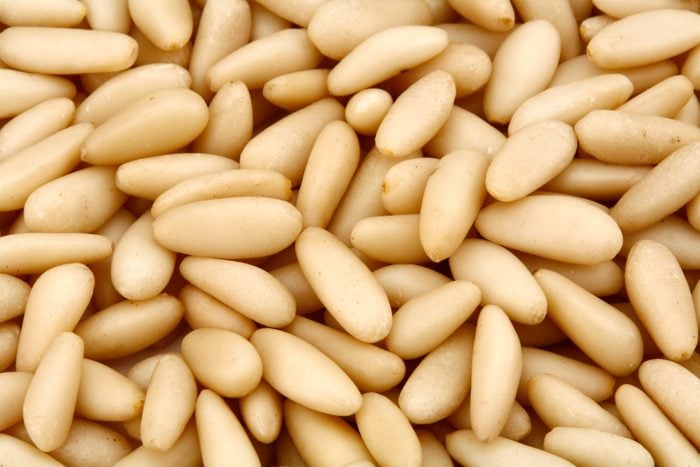What Is a Pine Nut, Exactly?
Updated: May 24, 2023

You might be surprised to find out where pine nuts actually come from—and how they're technically classified.
The beauty of food facts trivia is that there’s so much to learn. For example, have you ever wondered who invented pizza? Or if eggplant is a fruit or coconut a nut? We’ve got the answers to all of that and so much more, including the following questions that are not as straightforward as they sound: What are pine nuts, and where do pine nuts come from?
Pine nuts, of course, are the delicious little ingredients in one of our favorite foods: pesto. But are pine nuts actually nuts, and how, exactly, do they make their way to your kitchen? There’s a lot to know about this mysterious food, from its surprising origins to why it’s so pricey.
Where do pine nuts come from?
The funny thing about pine nuts is that they’re actually not nuts at all. Pine nuts (also called pignoli or piñón nuts) are the seeds of pine trees and can be commonly found in pine cones. According to Michigan State University, the pine nuts we buy usually come from stone pine and pinyon pine trees, because they produce a larger seed that’s better for eating and easier to harvest.
Pine nuts can come from a number of pine trees, though, and aren’t limited to those main two. However, different pine trees grow in different areas of the country and even around the world, which means pine nuts are different in different regions. So, where do pine nuts come from? They come from everywhere! And their story is strikingly similar to that of peanuts.
Are pine nuts tree nuts?
Pine nuts are a little bit tricky because they’re not technically nuts or even tree nuts. According to the Anaphylaxis Campaign, people who are allergic to tree nuts aren’t usually allergic to pine nuts and vice versa, because they belong to different classifications. However, this isn’t a hard-and-fast rule, as food allergies can vary from person to person. If you’re allergic to tree nuts, proceed with caution with pine nuts, just in case.
Why are pine nuts so expensive?
If you’ve ever shopped for pine nuts, you probably know that they come with a hefty price tag. While all nuts tend to be expensive, pine nuts are in the upper echelon of the pricing scale. This is because they’re not easy to harvest. A few factors affect this. For one, pine trees aren’t necessarily densely populated trees. Plus, getting the pine nuts from the trees and pine cones is a labor-intensive process. Add to all of this the fact that it takes a pine tree more than a decade to start to produce pine cones and pine nuts, and you’ve got yourself a long and arduous process that comes with a price tag to match.
When and how are pine nuts harvested?
Harvesting pine nuts is not an easy process. Pine cones take many months to grow the seeds that become pine nuts, and even then, the pine nuts aren’t ready to be harvested before the pine cones fully bloom. To speed up this process so that the pine nuts can be harvested, the pine cones are placed in burlap sacks and left out in the sun. This makes the extraction of the pine nuts slightly easier. The fun part of the process is quite literally smashing the pine cones to get the pine nuts out!
Now that you know where pine nuts come from, find out where vanilla flavoring comes from and what a macchiato actually is. You’ll definitely have loads of fun trivia to share at your next get-together!
Sources:
- Michigan State University: “Growing edible pine nuts in Michigan”
- Anaphylaxis Campaign: “Pine Nuts”
- Today: “Why are pine nuts so expensive? 4 reasons a small bag costs so much”
- Precision Nutrition: “Pine Nuts”
